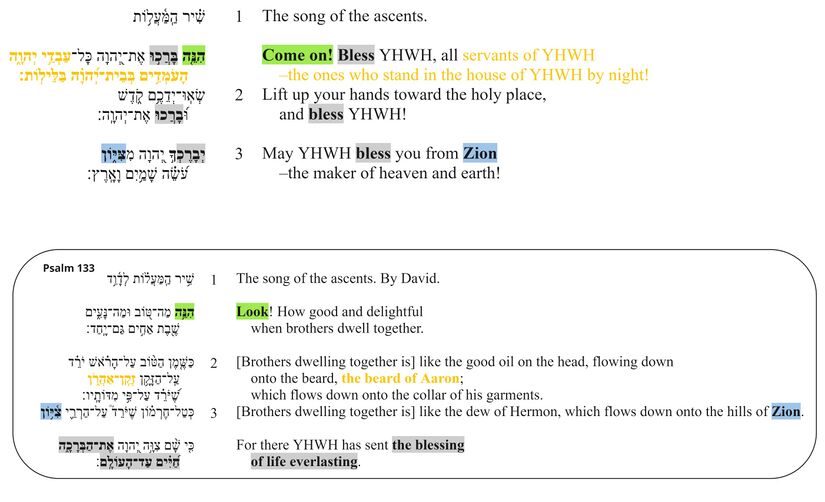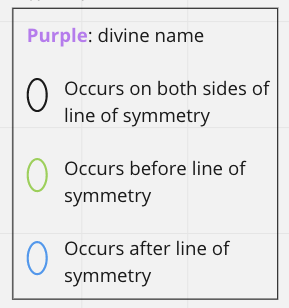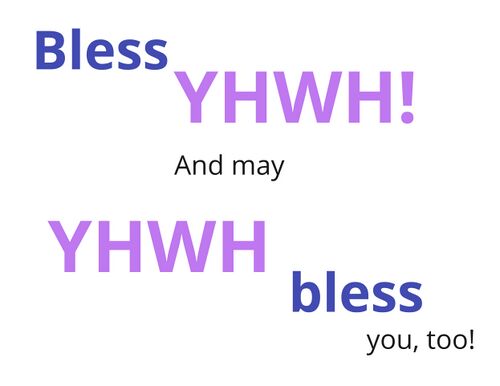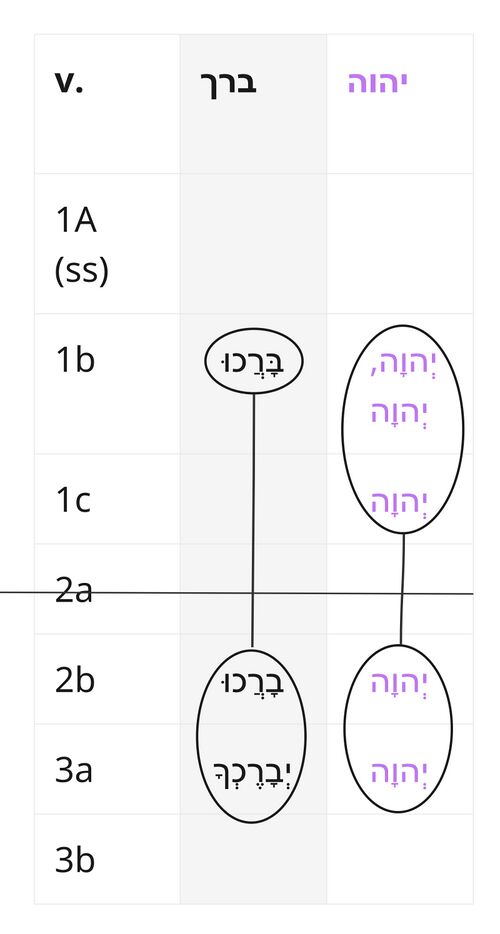Psalm 134 Poetics
About the Poetics Layer
Exploring the Psalms as poetry is crucial for understanding and experiencing the psalms and thus for faithfully translating them into another language. This layer is comprised of two main parts: poetic structure and poetic features. (For more information, click 'Expand' to the right.)
Poetic Structure
In poetic structure, we analyse the structure of the psalm beginning at the most basic level of the structure: the line (also known as the “colon” or “hemistich”). Then, based on the perception of patterned similarities (and on the assumption that the whole psalm is structured hierarchically), we argue for the grouping of lines into verses, verses into sub-sections, sub-sections into larger sections, etc. Because patterned similarities might be of various kinds (syntactic, semantic, pragmatic, sonic) the analysis of poetic structure draws on all of the previous layers (especially the Discourse layer).
Poetic Features
In poetic features, we identify and describe the “Top 3 Poetic Features” for each Psalm. Poetic features might include intricate patterns (e.g., chiasms), long range correspondences across the psalm, evocative uses of imagery, sound-plays, allusions to other parts of the Bible, and various other features or combinations of features. For each poetic feature, we describe both the formal aspects of the feature and the poetic effect of the feature. We assume that there is no one-to-one correspondence between a feature’s formal aspects and its effect, and that similar forms might have very different effects depending on their contexts. The effect of a poetic feature is best determined (subjectively) by a thoughtful examination of the feature against the background of the psalm’s overall message and purpose.
Poetics Visuals for Psalm 134
Poetic Structure
Poetic Macro-structure
- There are just two sections in this short psalm, which correspond to the switching of speaker and addressee that occurs between vv. 2 and 3. The first section is 1b-2, which corresponds to the congregation's speech. This section is further united by the threefold use of imperatives, and the inclusio of "bless YHWH".
- There's an alliteration in 1c, with similar sounds repeated in בְּבֵית and בַּלֵּילוֹת (Van der Lugt 2013:417)
- The second 'section' is just one verse, v. 3. This is the priests' return of blessing to the congregation. It is linked to the first section by the participle in apposition.
- The entire psalm (minus the superscription) is united into one section by the repetition of the key roots יְהוָה and ברך in each verse.
Line Division
- Line divisions follow the Masoretic accents (cf. de Hoop and Sanders forthcoming).
Poetic Features
1. The Domains of Heaven and Earth
Feature
The semantic domains of DIVINE, HUMAN, COMMUNICATION, and BUILDINGS are among the most repeated, and most important, domains in the psalm. DIVINE: The repeated name YHWH; heaven HUMAN: servants (priests); earth Elements of both HUMAN and DIVINE: house; holy place; Zion COMMUNICATION: bless (3x) BUILDINGS: house; holy place
Effect
This psalm is the last of the Psalms of Ascent (Pss. 120-134), and it represents the point at which the pilgrims are finally at their destination, the temple (BUILDING) in Jerusalem/Zion, the place where heaven (DIVINE) and earth (HUMAN) meet. At this place, blessings (COMMUNICATION) are exchanged between the people in the congregation of Israel (HUMAN) and YHWH (DIVINE). The semantic domains in the psalm thus illustrate the key ideas of this psalm, and how they interact.
2. Blessing the God of Blessing
Feature
This short psalm has two words that are repeated more than any other: "bless" and "YHWH". In verses 1 and 2, the priests/Temple workers are the ones who are being urged to do the blessing, with YHWH as the direct object/recipient of this blessing. Then, in verse 3, the words are repeated again, but there is a shift: YHWH becomes the subject of the verb "bless", with the congregation of Israel being the recipient of the blessing.
Effect
The dense repetition of 'bless' (3x) and 'YHWH' (5x) within such a short span of text highlights these words as key to the whole psalm.
The switch from referring to YHWH as recipient of blessing to agent of blessing that occurs in v. 3 is important; YHWH is not only worthy to receive all blessing, but he is also the source of all blessing. The switch thus underlines the reciprocal nature of the covenant relationship between YHWH and his people, Israel: Israel blesses YHWH, their God, and YHWH blesses Israel, his people.
3. Blessed Unity
Feature
This psalm, the last of the Psalms of Ascent, has numerous links to the preceding psalm, 133.
- Both psalms are very short (3 verses)
- Both psalms begin with the attention-getting particle הִנֵּה (cf. also the connection between 'dwelling' שבת and 'standing' עמד in the first verses).
- Both psalms mention the priests ('Aaron' in 133, and the 'servants of YHWH' in 134)
- Both psalms are about blessing.
- Both psalms mention Zion in verse 3.
Effect
The correspondences between the two psalms encourage reading them together as a unified whole. The 'brothers' in Ps. 133:1 are united, not only in their physical presence together, but also in their common commitment to blessing YHWH (Ps. 134:1) and experiencing his blessing (Ps. 134:3). The 'blessing' at Zion which is mentioned in Ps. 133:3 is liturgically actualized in Ps. 134, as YHWH blesses his unified people with life everlasting.
Repeated Roots
The repeated roots table is intended to identify the roots which are repeated in the psalm.
For legend, click "Expand" to the right







